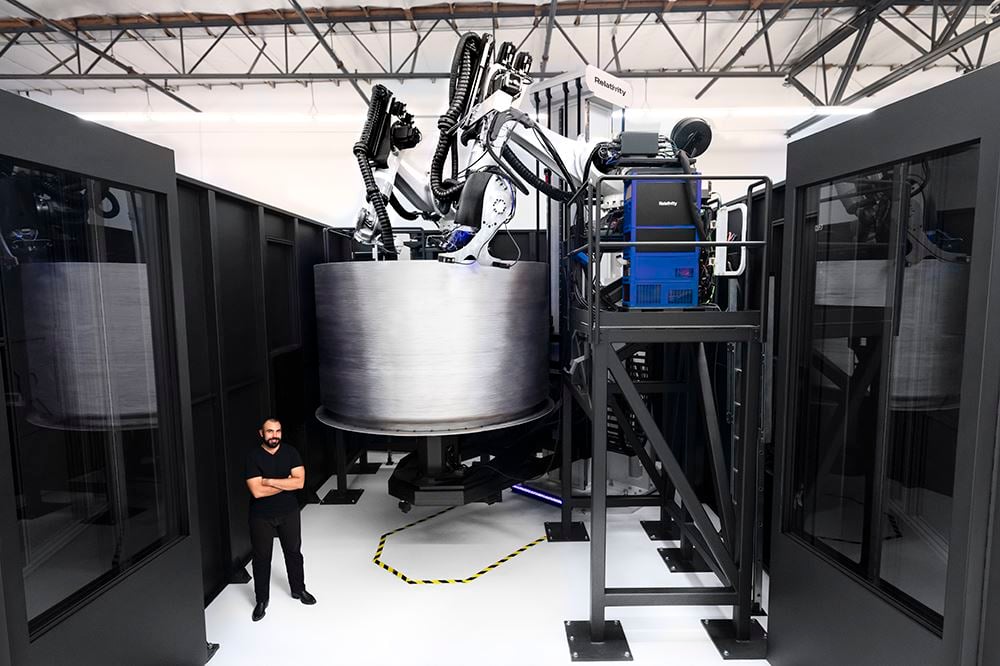![[Image: Relativity Space]](https://fabbaloo.com/wp-content/uploads/2020/05/relativityspace_img_5eb08f2788403.jpg)
Last week, Relativity Space announced a major funding round, bringing its fully 3D printed rockets closer to an out-of-this-world reality.
From the first, notable investors — think Mark Cuban and Y Combinator — have been a big part of Relativity’s strategy of 3D printing rockets. (Reminder: that’s rockets, not rocket components or engine parts.)
Current investors Cuban, Y Combinator, Playground Global, and Social Capital have been joined now in a Series C funding round by leaders Bond and Tribe Capital, as well as Lee Fixel, Michael Ovitz, Spencer Rascoff, Republic Labs, and Jared Leto.
Can we take a brief moment to appreciate that this guy is an investor in our industry? From 3D printed head to 3D printed rockets, Leto is impressively up on 3D printing.
Progress
Relativity Space’s (beyond-)sky-high plans may have initially seemed far-fetched, but are surprisingly grounded.
The company has been growing steadily and progressing on to its goals. Ultimately, it’s hoping to 3D print the first rocket made on Mars, because why not, but has a lot of milestones already accrued and many more set to be marked on the journey to Mars.
On the tech side, Relativity’s press release notes:
“Among the technology milestones achieved are building fully printed first and second stage structures, printing and assembling a second stage, successful and intentional burst testing of Stargate printed stage structures to demonstrate ability to hold pressure, completion of first turbopump tests, completion of more than 200 engine hotfire tests at NASA Stennis Space Center, completion of the avionics architecture and hardware testing, and completion of the Terran 1 vehicle system design and coupled loads analysis.”
This summer, Relativity announced a massive 3D printer farm to make its rockets. Last month, they introduced their first customer.
Well ahead of any Martian endeavor, the company is looking much nearer-term and nearer-Earth, with early 2021 in sight to enter into commercial service as they seek to become the first to put a fully 3D printed rocket into orbit.
Financing
Obviously, these goals aren’t small — and neither is the need for funding.
While 3D printing in operations is significantly cutting back on part counts, build and launch times, and other traditionally expensive aspects of rocketry, it’s still, well, rocket science. And that’s not cheap.
The most recent funding round for the company was a Series B that closed last spring. When Relativity announced its $59M factory setup this summer, we noted that three investment rounds had pulled in $45.7M at that time — a significant amount, but one that indicated, as Kerry wrote in June, “that Relativity Space has obtained, or will obtain, additional cash from another source.”
And so they have. The $140 million just announced isn’t just some nice pocket cash for an ambitious startup — that’s a major figure that aligns with the real-world needs of off-Earth travel.
Relativity Space is very much growing, on track to have more than 480,000 square feet of infrastructure by the end of this year — up about 200,000 square feet from its latest expansion. The team is also gaining capacity, increasing 8x over the last year to 110 employees as more funding is paying more necessary salaries.
Also benefiting the venture are its ties to other entities, notably the US government. They report:
“Relativity became the first venture-backed company to secure a launch site Right of Entry at Cape Canaveral Launch Complex-16 from the U.S. Air Force, secured a 20-year exclusive-use Commercial Space Launch Act (CSLA) agreement for five NASA test sites including E3 and E4 and a 20-year exclusive use lease for a 220,000 square feet factory at NASA Stennis Space Center, and became the only venture-backed company on the National Space Council User’s Advisory Group advising the U.S. White House. Relativity expects to secure a polar and Sun Synchronous Orbit (SSO) capable launch site by the end of 2019.”
Customer contracts are in place now not only with last month’s reported relationship Momentus, but also Telesat, mu Space, and Spaceflight Industries.
All in all, these are impressive growth milestones for an impressive company — but maybe for Relativity Space, that’s just business as usual.
“Relativity was founded with the long term vision of 3D printing the first rocket made on Mars and expanding the possibilities for human experience in our lifetime,” said Tim Ellis, Co-Founder and CEO of Relativity Space. “With the close of our Series C funding, we are now one step closer to that vision by being fully funded to launch Terran 1 to orbit as the world’s first entirely 3D printed rocket. Bond and Tribe are unrivaled partners in leading this funding round, and we are excited to build this important future together with our entire team.”
Via Relativity Space

